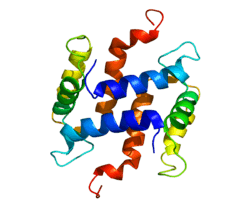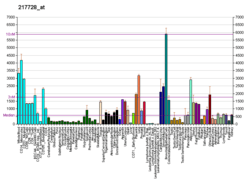S100 calcium-binding protein A5 (S100A5) is a protein that in humans is encoded by the S100A5 gene.[5][6]
The protein encoded by this gene is a member of the S100 family of proteins containing 2 EF-hand calcium-binding motifs. S100 proteins are localized in the cytoplasm and/or nucleus of a wide range of cells, and involved in the regulation of a number of cellular processes such as cell cycle progression and differentiation. S100 genes include at least 13 members which are located as a cluster on chromosome 1q21. This protein has a Ca2+ affinity 20- to 100-fold higher than the other S100 proteins studied under identical conditions. This protein also binds Zn2+ and Cu2+, and Cu2+ strongly which impairs the binding of Ca2+. This protein is expressed in very restricted regions of the adult brain.[6]
Further reading
- Schäfer BW, Heizmann CW (1996). "The S100 family of EF-hand calcium-binding proteins: functions and pathology". Trends Biochem. Sci. 21 (4): 134–40. doi:10.1016/S0968-0004(96)80167-8. PMID 8701470.
- Schäfer BW, Wicki R, Engelkamp D, et al. (1995). "Isolation of a YAC clone covering a cluster of nine S100 genes on human chromosome 1q21: rationale for a new nomenclature of the S100 calcium-binding protein family". Genomics. 25 (3): 638–43. doi:10.1016/0888-7543(95)80005-7. PMID 7759097.
- Ridinger K, Ilg EC, Niggli FK, et al. (1999). "Clustered organization of S100 genes in human and mouse". Biochim. Biophys. Acta. 1448 (2): 254–63. doi:10.1016/S0167-4889(98)00137-2. PMID 9920416.
- Schäfer BW, Fritschy JM, Murmann P, et al. (2000). "Brain S100A5 is a novel calcium-, zinc-, and copper ion-binding protein of the EF-hand superfamily". J. Biol. Chem. 275 (39): 30623–30. doi:10.1074/jbc.M002260200. PMID 10882717.
- Bronckart Y, Decaestecker C, Nagy N, et al. (2002). "Development and progression of malignancy in human colon tissues are correlated with expression of specific Ca(2+)-binding S100 proteins". Histol. Histopathol. 16 (3): 707–12. PMID 11510959.
- Teratani T, Watanabe T, Yamahara K, et al. (2002). "Restricted expression of calcium-binding protein S100A5 in human kidney". Biochem. Biophys. Res. Commun. 291 (3): 623–7. doi:10.1006/bbrc.2002.6494. PMID 11855835.
- Strausberg RL, Feingold EA, Grouse LH, et al. (2003). "Generation and initial analysis of more than 15,000 full-length human and mouse cDNA sequences". Proc. Natl. Acad. Sci. U.S.A. 99 (26): 16899–903. doi:10.1073/pnas.242603899. PMC 139241. PMID 12477932.
- Chan WY, Xia CL, Dong DC, et al. (2003). "Differential expression of S100 proteins in the developing human hippocampus and temporal cortex". Microsc. Res. Tech. 60 (6): 600–13. doi:10.1002/jemt.10302. PMID 12645008.
- Gregory SG, Barlow KF, McLay KE, et al. (2006). "The DNA sequence and biological annotation of human chromosome 1". Nature. 441 (7091): 315–21. doi:10.1038/nature04727. PMID 16710414.






